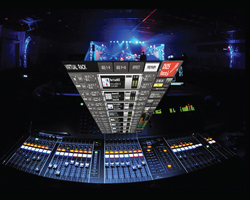
Roland Systems Group. The M-480 is the flagship of the V-Mixer Series, which includes five models offering many of the same capabilities along with a lot of interconnectivity. For example, the M-480 is configurable to 90 inputs and 90 outputs depending on the digital snake configuration.
The M-480 includes 4-band parametric EQ and delay (up to 400 msec) on all inputs and outputs, the latter significant because it makes for fast, simple compensation of delay problems via the console’s internal process. All mixing channels include compressors and gates.
Also onboard are 6 stereo (dual-mono) multi-effects processors that are available as aux or insert effects. Each multi-effects processor has 18 algorithms of various types, such as reverb, delay, chorus, pitch shift and advanced channel strip. Six types of emulated vintage Roland effects like the RE-201, SDE-3000, and SRV-2000 are included.
In addition, the M-480 provides 12 31-band graphic EQs or 8-band fully parametric EQs. The 6 multi-effects and 12 GEQs/PEQs can be used simultaneously for a total of 24 GEQs if needed.
PreSonus. The StudioLive Series has proven quite popular, offering a tremendous amount of capability in a compact footprint that’s attractively priced. The newest model, StudioLive 32.4.2AI, offers the company’s “Active Integration,” a networked, tightly integrated hardware/software ecosystem. It includes 50 onboard effects covering a wide range of reverbs and delays.
There are also 4 programmable, 32-bit stereo DSP effects engines, 2 loaded with reverbs and 2 with delay effects. Each stereo processor has its own dedicated internal FX bus, and all 4 can be used at once without compromising other resources. Dynamic effects (compressor, gate and limiter) as well as extensive EQ, are native on each input channel, each output, and on all aux sends.
Particularly handy is the ability to create 2 complete sets of EQ and dynamics-processor settings for every input channel and bus, and then make quick A/B comparisons at the touch of a button. This eliminates the need to tie up a second channel for musicians who change instruments from one song to another and need different channel strip settings whenever they change.
Additional Options. We didn’t want to overlook the new SSL Live console, although it’s of a different scope than the other models presented here. A quick overview shows processing paths that include a 4-band parametric that can be switched between a precise constant-Q mode and “SSL Legacy EQ,” high- and low-pass filters with selectable slopes, SSL dynamics presented as separate compressor, analog-style tube emulator, expander/gate, as well as a delay line and an all-pass filter.
At the other end of the spectrum are the popular Mackie DL Series iPad mixers (DL1608 and DL808). In “modern” mode, inputs have 4-band EQ that include low shelving, low-mid peaking, high-mid peaking and high shelving, as well as compression and gating. Meanwhile, “vintage” mode provides musical characteristics of a host of popular processors, including vintage EQ with interacting bands and frequency-dependent Q structure, vintage compressor with non-linear attack/release, and vintage gate with fast attack for transient sources. Each output has its own processing as well, including 31-band GEQ with the ability to draw in the curve or adjust manually, along with compression/limiting.
In addition, global reverb and delay can be applied to any channel. Nine reverbs are available, each with pre delay, damping, decay and roll-off controls. There’s also a choice of mono, tape echo, stereo, ping-pong or multi-tap delay, each with tap tempo, feedback and damping control.
